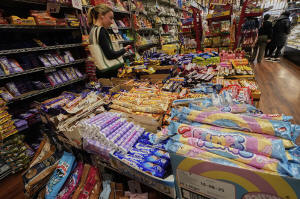Trump's tariffs hit a sour note in landmark NYC emporium of sweets
[April 07, 2025] By
MATT SEDENSKY
NEW YORK (AP) — Economy Candy’s shelves brim with sweets from around the
world – gummies from Germany, lollipops from Spain, chocolates from
Japan and a panoply of candies from across the U.S.
Standing amid it all, columns of bright jellybeans to his left and
exotic Kit Kats to his right, owner Mitchell Cohen is quick with his
assessment of how many of this shop’s 2,000-plus items are affected by
the historic round of tariffs announced by President Donald Trump.
“I think all of them,” Cohen says at his store on New York's Lower East
Side.
Few corners of the American economy are untouched, directly or
indirectly, by the sweeping tariffs being imposed by Trump. Even a
little store like Economy Candy.
Cohen had just begun to feel a barrage of inflation-driven price
increases from suppliers ease when the tariff threats arrived. For a
business with a name like Economy Candy, he wants to remain affordable
but fears how high some prices may have to climb in the coming months.
“I think it’s gonna be another round of this hyperinflation on some
items,” says 39-year-old Cohen. “If we’re putting tariffs everywhere, it
is going to go up.”
Stepping into Economy Candy feels like a time warp. Its name is
emblazoned on a sign in a vintage, blaring red script, and crossing
below its green-and-white striped awning, past the bins of Smarties,
butterscotches and Lemonheads in the front window, an indecipherable
sweetness fills the air, oldies music sounds overhead and customers mill
around stacks of candy bars they forgot still existed.

It represents just a blip in the country’s $54 billion candy industry.
But it was already feeling the weight of surges in prices of cocoa and
other ingredients before tariffs were layered on.
Candy and gum prices are up about 34% from five years ago and 89% from
2005, according to Consumer Price Index data. Price, according to the
National Confectioners Association, has become the top factor in
consumers’ candy purchase decisions, outweighing a buyer's mood.
About a third of Economy Candy’s products are imported, crowded on
shelves and tables near the store’s rear. There aren’t just “more German
Haribo varieties than the Haribo store in Germany,” as Cohen claims, but
gummies the brand makes in France, Austria and Britain.
They have every Milka bar they can find in Switzerland, every type of
Leone hard candies that Italy churns out and as many exotic Kit Kats
from Japan as they can fit.
On products like these, the tariffs’ toll is obvious.
Pistachio Snickers bars are from India, now subject to 26% tariffs,
while passion fruit mousse Snickers are from Portugal, now under the 20%
European Union levies.
But even an American-made Snickers isn’t immune.
While the bars may roll off conveyors in Texas, they rely on ingredients
from around the globe. Sourcemap, which tracks supply chains, says
Snickers bars include chocolate from Guyana and sugar from Brazil and
are wrapped in packaging from Canada. All are now subjected to varying
levels of tariffs.
“There’s a lot of ingredients in there that have to come from other
countries,” says Andreas Waldkirch, an economics professor at Colby
College who teaches a class on international trade. “Unless you’re
talking about something very simple from your local farmers market,
almost every product relies on ingredients from elsewhere. Those
indirect costs are really what’s going to drive up prices.”
The story repeats with American candies across the store – the boxes of
Nerds and bags of Sugar Babies and rolls of Smarties are all
inextricably tied to the global supply chain.
A table teeming with those domestic delicacies takes center stage near
Economy Candy’s entrance. Cohen took over the store from his parents,
who took it over from their parents before. He got his first haircut in
the store. He was behind the register as a child. He took his wife by on
their first date.

[to top of second column] |

Candies from around the world are displayed for sale at Economy
Candy in New York's Lower East Side, Friday, April 4, 2025. (AP
Photo/Richard Drew)
 As a kid, everything on the store’s
centerpiece table of American treats cost 59 cents. By 2020, the
price was $1.29, but customers who bought a whole box paid a
discounted rate of $1 per piece.
Now, Cohen can’t even get them wholesale at that
price.
Today, he sells the items on the table for $1.59. Cohen calls the
selection a “loss leader” but thinks it's important to showcase his
store's affordability. Once the tariffs are fully implemented, he’s
not sure he’ll be able to put off price increases.
“When your margins are coming down and your dollar doesn’t go as far
at the end of the day, you really start to feel it,” he says. “But I
don’t want anyone to come into Economy Candy and not think that it’s
economical.”
The biggest-ticket implications of the tariff blitz understandably
gain the most attention – the thousands of dollars a car’s price tag
may grow, the tens of thousands that disappear from a retirement
account in a single day. But here among the root beer barrels and
licorice strands, you're reminded that small-dollar items are
affected too, and so are the families selling them.
At its birth, the business Cohen’s grandfather started focused on
shoe and hat repairs. But in the wake of the Great Depression, when
few in a neighborhood of crowded tenements had money for such fixes,
the business pivoted.
Candy, once relegated to a cart out front, took over the store.
In the 88 years since, business hasn't always been Chuckles and
Zagnuts. The Sept. 11 attacks kept tourists away and had sales
sagging and the pandemic closed the store and forced it to pivot to
online sales.
If tariffs upend things, Cohen isn’t sure how he might adapt again.
He sells products that aren’t made in America and he sells American
products made with ingredients from across the globe. He had just
been making headway on beginning international sales, but the web of
tariff rules may make it impossible.
The average U.S. tariff could rise to nearly 25% if the import taxes
Trump put on goods from dozens of countries are fully implemented
Wednesday. That would be the highest rate in more than a century,
including tariffs widely blamed for worsening the Great Depression.

Trump said imposing the tariffs amounted to a “liberation day” for a
country that has been “looted, pillaged, raped and plundered” by
friend and foe alike, insisting it was “very, very good news” for
the U.S.
Cohen isn't sure how that can be true for a business like his.
“I can understand bringing manufacturing and bringing things back to
America, but you know, we rely on raw materials that just aren’t
native to our country,” he says. “And it’s not like I can get a
green tea Japanese Kit Kat from an American company.”
As Cohen stood before mounds of strawberry candies in shiny wrappers
and little cubes of caramel in cellophane, the first word of the
tariff’s concrete impact on him arrived. A French supplier emailed
saying it was immediately imposing a 5% surcharge due to the
tariffs, expressing regret for the move and hope that “the situation
will be resolved swiftly.”
Cohen wore a smile anyway. He wants this to be a happy place for
visitors.
“You travel back to a time when nothing mattered,” Cohen says, "when
you didn’t worry about anything.”
All contents © copyright 2025 Associated Press. All rights reserved |